 |
| Sunset comes earlier, shadows lengthen |
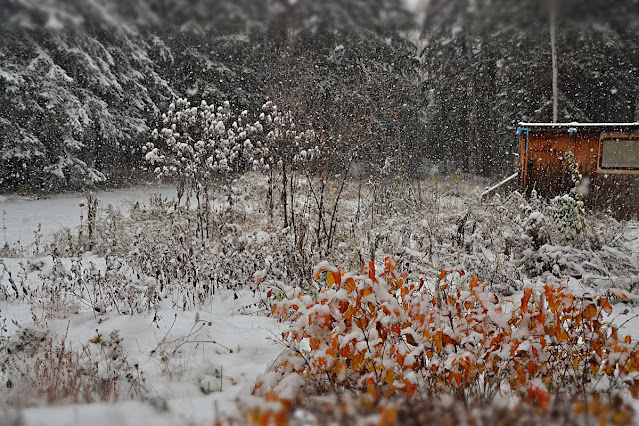 |
| First snow over the Eurasian-mesic beds and veg beds behind |
(Here's a little video- me in the bush, just beyond the acreage, talking a little about the Cross-quarter Day, looking at the afternoon sun through the trees, wishing you all well for the season!
https://youtu.be/ZI81KOBZcBc )
It's a bit hard to pin down Mārtiņš the titular deity of Martiņi or Martin's Day (Latvian celebration at the beginning to middle of November) and the meaning of the day, itself. First the god and the day have been conflated with the Christian saint of the same name, celebrated around the same time. That part holds no interest for me. The pagan, pre-Christian roots of the celebration are clear enough: this is the cross-quarter day, midway between Autumn Equinox and Winter Solstice. This marks the ending of Veļu Laiks, the Time of Spirits (not a scary time, rather a time to honour and remember loved ones who have died) which extends from the end of harvest till the beginning of winter, Ledus Laiks, Time of Ice. Winter is welcomed, and Spirits now go off to the 'Place Beyond the Sun' (traditionally West, across the sea, for me that would be into /across the mountains). Perhaps the departing Spirits follow Saulė to warmer climes down south!
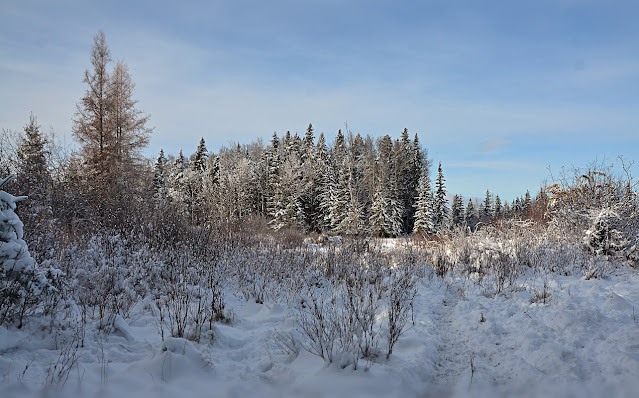 |
| First snow, wetland on the farm |
Celebrations are many, varied, layered. Perhaps a final farewell to loved ones who have died (a place at dinner, family time at the grave etc), then celebration of the ending of autumn and completion of preparations for winter. Of course traditional social gatherings, including masks/costumes, song and dance and surely food. I've read of various practises and traditions- no doubt there are regional and historical variations, as well as degrees of Christianisation and influence from other cultures that have held power in Latvia. One I've seen mentioned is wearing masks with particular powers attributed to them- a crane mask- who may pinch you with its beak to drive away negativity/bad spirits; a bear who will roar in your house to bring good luck (presumably also by scaring away evil spirits!); and a death mask- dancing with death to purge you of sickness and weakness. This brings up something referred to as 'upside-down magic' also associated with the day- appealing to the opposite of one's objective, like dancing with death for health, or singing a sort of insult battle with someone, in order to become friends! I wonder if this is part of the idea of this being a time where lines blur between mundane and spirit worlds- where things may be opposite?
(see these articles for more: https://www.baltictimes.com/news/articles/19218/ https://www.baltictimes.com/news/articles/29911/ https://comefollowmy.blog/2022/11/14/martin-day-the-end-of-velu-laiks/ )
 |
| Sorbus Leaves in New Snow |
Mārtiņš himself is another matter- not simply or originally a Christian saint, he was one of the sons of the Sky God, the Indo-European Father God. He is associated with horses, and is linked to Ūsiņš , celebrated in spring- one and the same or perhaps originally the Indo-European twin gods? His traditional sign is associated with fertility, productivity and prosperity. Another of the practises for Martiņi was for young women to throw their skirts on the floor before bed, to be picked up by a lover/future husband -metaphorically? by an actual visitor? These practises around mate finding seem as common on various holidays as those meant to promote health, wealth and good harvest- universal concerns- all enhanced by efforts to dispel negativity/bad spirits! Besides the many other social, cultural and calendrical functions of the holy days of Solstices, Equinoxes and cross-quarter days, they likely marked important times for those living relatively isolated rural lives to meet new and old friends, allies and potential mates.
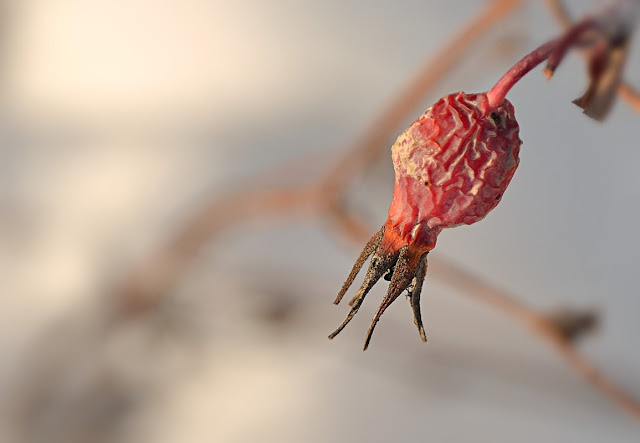 |
| Wild Rose hip in the snow |
I'd love to know to what extent the Indo-European gods simply added to the pantheon of ancient deities worshipped in the area, and to what extent they replaced them. There is certainly at least some indication that ancient Goddess worship continued: alongside the new gods where permitted, in secret when it was not, and very often blended, with existing deities combined with new ones whose characteristics/purviews were the same or overlapping. I've done just a little reading on the complex subject of the Indo-European 'take-over' of "old Europe' as some call it. (This is a nutshell version- please read more if interested, it's a complex and evolving interdisciplinary field of study.) Many of the languages of Europe, Central Asia into northern India share a language family. At some point in pre-history, the original language and presumably associated cultures spread from a point of origin possibly south of the Caucasus. There has been debate on how much of the spread was cultural, how much the result of migrations and conquest. Recent genetic studies have added to this debate- too much to go into here. I will just say: I have seen the suggestion, at least, that in the Baltics, in particular, at least part of the Indo-European incursion to the 'Old European' populations was by intermarriage (not necessarily always as peaceful as that sounds). For example: warrior bands and/or larger groups may have taken control of an area, becoming the ruling class, the men then 'intermarrying with' the local women-('taking' women?). DNA can be traced to a degree by male and female lineages, so the mothers' lines show more of the old DNA types, the fathers' lines more of the 'invader' DNA. (This is grossly simplified, just gives you an idea of some of what is being studied). This leads to the thought that elements of culture- such as Goddess worship- which may have been considered 'women's business' may have remained more intact than such things as the language of chieftains!
(more: there are many papers, and I'm not sure I will re-find everything I read while thinking about this!
https://www.ncbi.nlm.nih.gov/pmc/articles/PMC9942792/ https://www.ncbi.nlm.nih.gov/pmc/articles/PMC5789860/ https://en.wikipedia.org/wiki/Kurgan_hypothesis )
My knowledge and understanding of the science here is incomplete, and in fact research is still untangling what was probably a prolonged, complex and varied cultural transition. I just find the idea appealing that the most ancient spiritual practises may have survived through Mothers down the millenia. Maybe it is not a coincidence that Latvian pre-Christian tradition names a host of lesser goddesses or aspects of the Great Goddess/Great Mother: referred to as Mothers or 'Little Mothers'- who are the embodiment of all natural forces, objects, lives, domestic concerns (Snow Mother, Leaf Mother, Mother of Laziness(!)).
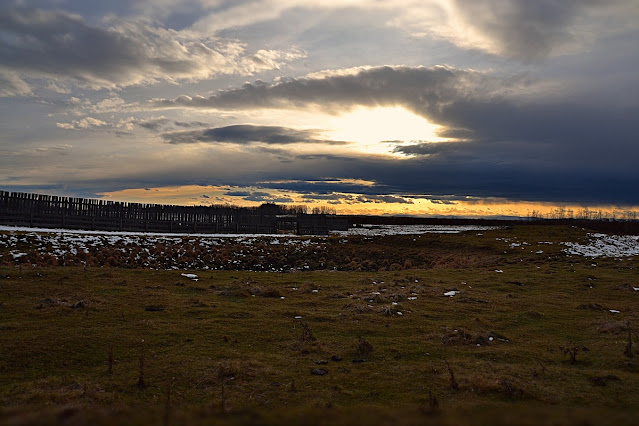 |
| Pre-sunset across the neighbours', Sun gets lower and farther south each day... |
Archaeomythology aside, as always, I try to find the elements in these traditions that can relate to my life. I don't keep horses and not concerned with personal fertility (!) but general productivity (in my idiosyncratic terms) and the health and viability of soil, plants, ecosystems etc is always relevant. So, I'll give a thought to Mārtiņš. I'll keep him in mind as the twin of Ūsiņš , who I have a bit of a soft spot for (blog post here: Ūsiņš), even though I mostly by-pass the Indo-European gods and go to the primordial goddesses that came before! Maybe he has a role stewarding cultivated land, along side Great Mother/ Māra and her ancient manifestations. He may also be associated with fire, and we've just started the fires that will heat the house till summer. I need to learn more about this. I'll think of loved ones who have gone on, accompanying Saulė/Sun on her journey home. I'll be thinking of that journey taking her farther and farther south as we head to Solstice. I'll be gathering strength, courage for the hard work the Time of Ice brings here in country living.
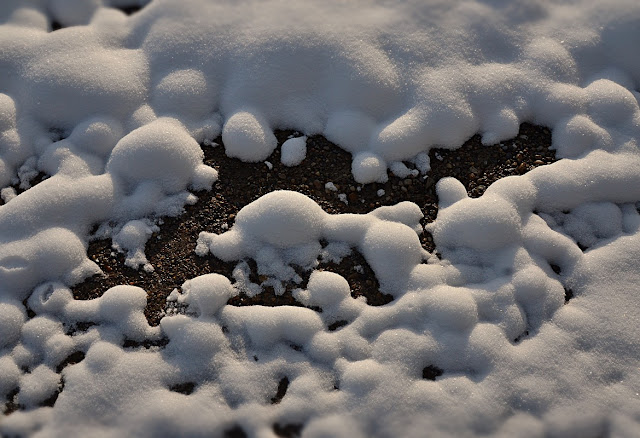 |
| Uncommitted snow on the driveway |
May you see the beautiful light of the season, may Snow Mother brighten your days and nights, may your spirit soar with Saulė on her journeys away and back, may Mārtiņš keep your heart safe and warm with the sacred fire of love and kinship (wherever you find or build it!) tucked into the nurturing soil/darkness of Great Mother/Māra!
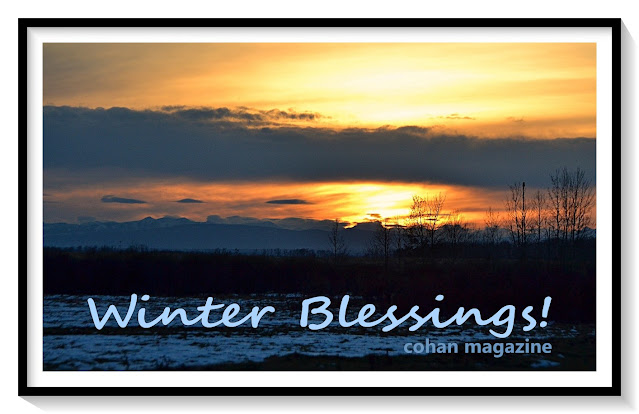 |
| Sunset November 06, day before the cross-quarter day |
Comments on the ease of reading on this platform are welcome. I'm also starting to experiment with Wordpress. You can find me on
If you are able and would like to support me, I have a Ko-fi page; support helps me keep working-more research, more writing, more art!
(see this post for musings on support sites: https://cohanmagazine.blogspot.com/2021/01/fiction-feedback-and-finances.html ).
As usual, if you love an image, it could be loaded to any of the print on demand sites as cards, prints, mugs, clothing etc. Haven't played with any of those for a while, hope to get back at them soon.
Comments
Post a Comment